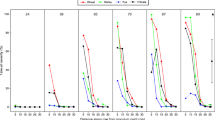Abstract
Wheat plants were grown at three levels of zinc nutrition in potted soil under controlled conditions. The surface soil in half of the pots was inoculated with a thin layer of milled chaff colonized byFusarium graminearum Group 1. Forty days after sowing, the plants were assessed for dry matter production and the extent of colonization by the pathogen. The concentration of zinc in the plant tissues was also determined.
The zinc status of the plants ranged from severe deficiency through subclinical deficiency to sufficiency. The extent of colonization above the point of infection was decreased significantly by increasing the level of zinc supply. However, colonization of the seminal or secondary roots was not affected by zinc supply, nor was the incidence of infected plants. The unidirectional effect on resistance suggests that zinc has modified the contribution of the xylem flux to the upward spread of the pathogen.
Similar content being viewed by others
References
Basu-Chaudhry K C 1967 Influence of copper and zinc on the incidence of potato scab. Neth. J. Plant Pathol. 73, 49–51.
Bettger W J and O'Dell B L 1981 A critical physiological role of zinc in the structure and function of biomembranes. Life Sci. 28, 1425–1438.
Bolle-Jones E W and Hilton R N 1956 Zinc deficiency ofHevea brasiliensis as a predisposing factor to Oidium infection. Nature (Lond.) 177, 619–620.
Burgess L W, Klein T and Liddell C M 1984 Crown Rot of Wheat.In Research on Root and Crown Rots of Wheat in Australia. Proceedings of a workshop held in Adelaide, 14th and 15th February, 1984.
Donald C M and Prescott J A 1975 Trace elements in Australian crop and pasture production, 1924–1974.In Trace Elements in Soil-Plant-Animal Systems. Eds. D J D Nicholas and A R Egan. Academic Press, pp 7–37. New York, San Francisco, London.
Francis R G and Burgess L W 1977 Characteristics of two populations ofFusarium roseum ‘Graminearum’ in eastern Australia. Trans. Br. Mycol. Soc. 68, 421–427.
Galdes A and Vallee B L 1981 Categories of zinc metalloenzymes.In Metal Ions in Biological Systems, Volume 15 Ed. H Sigel, pp. 1–54.
Graham R D 1983 Effects of nutrient stress on susceptibility of plants to disease with particular reference to the trace elements. Adv. Bot. Res. 10, 221–276.
Graham R D and Rovira A D 1984 A role for manganese in the resistance of wheat plants to take-all. Plant and Soil 78, 441–444.
Liddell C M and Burgess L W 1987 A technique for manipulating the time of infection of wheat byFusarium graminearum Group 1. Plant Protection Quarterly 2, 103–107.
McIlveen W D and Cole H 1979 Influence of zinc on development of the endomycorrhizal fungusGlomus mosseae and its mediation of phosphorus uptake byGlycine max ‘Amsoy 71’. Agric. Environ. 4, 245–256.
McKnight T and Hart J 1966 Some field observations on crown rot disease of wheat caused byFusarium graminearum. Q. J. Agric. Anim. Sci. 23, 373–378.
Mengel K and Kirkby E A 1982 Principles of Plant Nutrition. 2nd ed. International Potash Institute, Berne, Switzerland.
Purss G S 1966 Studies of varietal resistance to crown rot of wheat caused byFusarium graminearum Schw. Q. J. Agric. Anim. Sci. 23, 475–498.
Reuter D J and Robinson J B (eds.) 1986 Plant Analysis, Interpretation Manual. Inkata Press, Melb. 218 p.
Sharp L E and Smith F G 1952 The influence of pH and zinc on vesicle formation inPuccinia coronata avenae Corda. Phytopathology 42, 581–582.
Shukla U C and Raj H 1974 Influence of genetic variability on zinc response in wheat. Soil Sci. Soc. Am. Proc. 38, 477–479.
Tio M, Burgess L W, Nelson P E and Toussoun T A 1977 Techniques for isolation, culture and preservation of the Fusaria. Aust. Plant Pathol. Soc. Newsl. 6, 11–13.
Welch R M, Webb M J and Loneragan J F 1982 Zinc in membrane function and its role in phosphorus toxicity. Proc. 9th Int. Plant Nutri. Colloq. pp. 710–715.
Zarcinus B A 1984 Analysis of soil and plant material by inductively coupled plasma-optical emission spectrometry. Comparison of digestion procedures for major and trace constituents in plant material. Aust. CSIRO Div. Soils, Div. Rep. No. 70.
Author information
Authors and Affiliations
Rights and permissions
About this article
Cite this article
Sparrow, D.H., Graham, R.D. Susceptibility of zinc-deficient wheat plants to colonization byFusarium graminearum Schw. Group 1. Plant Soil 112, 261–266 (1988). https://doi.org/10.1007/BF02140004
Received:
Accepted:
Issue Date:
DOI: https://doi.org/10.1007/BF02140004




